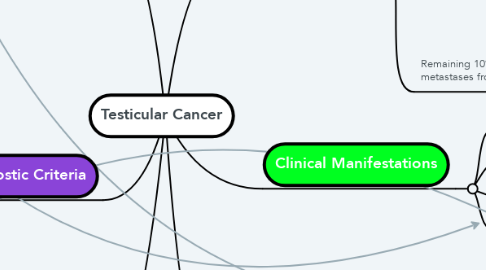Testicular Cancer
por McKenna Nielsen


1. Risk Factors
1.1. Cryptochidism: undescended testis (20-40x more likely to develop cancer)
1.2. Alteration in chromosome 14
1.3. Most commonly found in men 20-40 years of age
2. Diagnostic Criteria
2.1. Monthly self-testicular examination is important for early detection
2.2. Primary diagnosis through physical exam and radical orchiectomy (testicle removal)
2.3. Transscrotal biopsy is not recommended because it may result in seeding of the tumor into the scrotum
2.4. Ultrasound, CT scan, and MRI used to identify tumor location and spread
3. Treatment
3.1. Depends on the cell type and stage
3.2. Highly treatable and often curable cancer
3.3. Surgical removal of tumor and affected testicle
3.4. Radiation and Chemotherapy
4. Pathophysiology
4.1. Approximately 90% of tumors arise from germ cells
4.1.1. Seminomas: malignant germ cells that resemble primitive sperm cells (most common type of testicular cancer)
4.1.1.1. Begins with a germ cell mutation (likely during fetal development) that results in proliferation of immature spermatogonia, which causes the testicular cancer tissues to become enlarged and fibrotic
4.1.2. Nonseminomas: malignant germ cells that do not resemble promotive sperm cells and actually appear as embryonic or undifferentiated somatic components
4.1.2.1. Embryonal carcinomas: resemble primitive undifferentiates embryonic tissue
4.1.2.2. Yolk sac tumor
4.1.2.3. Choriocarcinomas
4.1.2.4. Teratocarcinomas: combination of embryonic carcinomas and undifferentiated somatic

